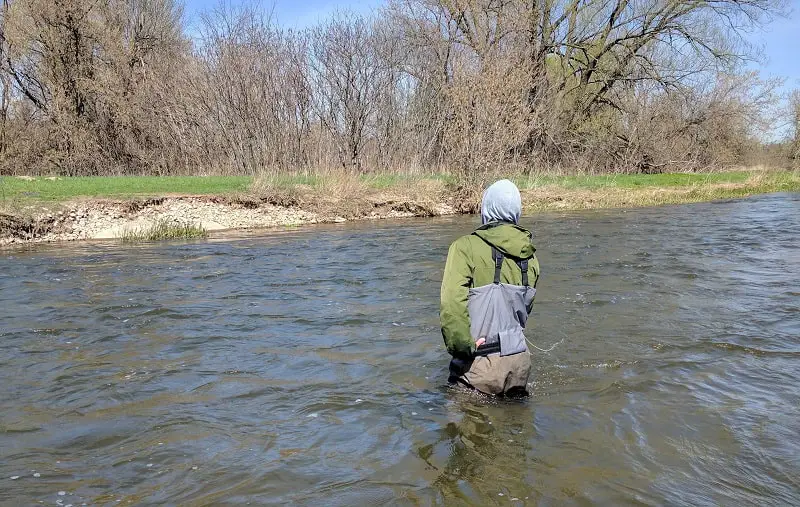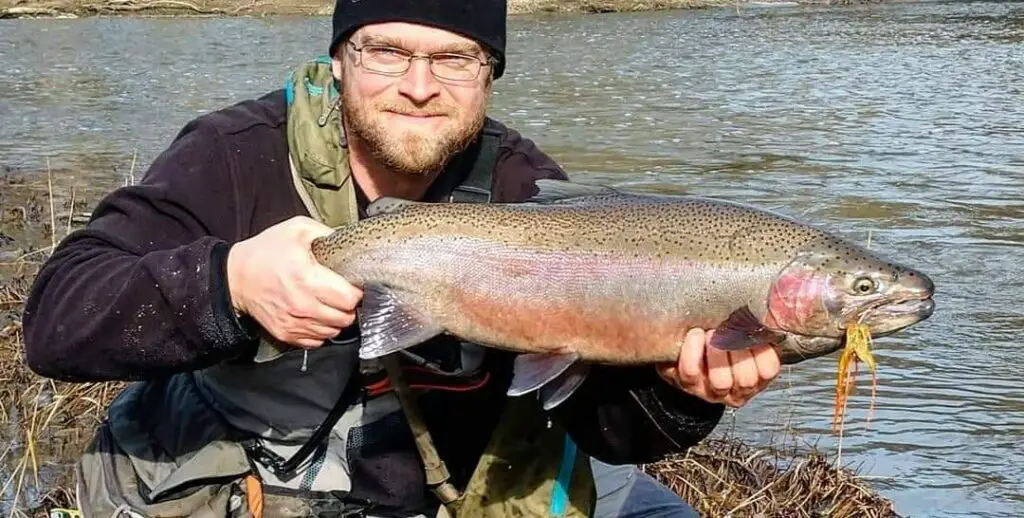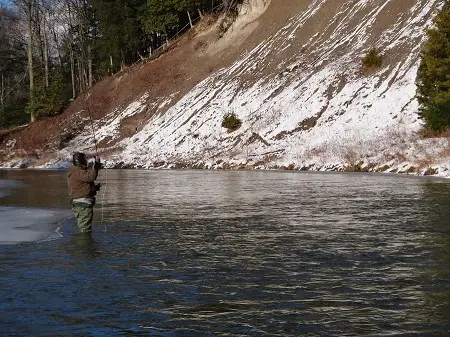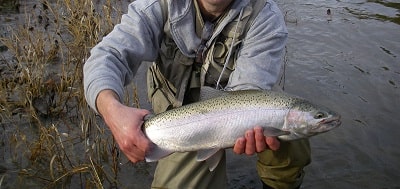Ohio Steelhead Run: Guide Tips For Timing The Runs

The steelhead run in Ohio consists of tens of thousands of steelhead entering the rivers from fall to spring. The steelhead runs can be small pods of less than a hundred steelhead at a time or it can be thousands of steelhead entering the river in less than 48 hours.
Being able to time the runs so that I’m on the water at the right time significantly increased my ability to catch more steelhead.
Timing the runs effectively is the difference between being there on the right day and hooking over fifty steelhead or being there four days later and struggling to catch a few steelhead.
Timing The Ohio Steelhead Run

They say timing is everything when it comes to the steelhead run, and I agree.
A new client messaged me to find out my guiding schedule because he had been fishing all spring and hadn’t hooked any steelhead yet.
The same day, I got a text from my buddy asking me if I was on a certain river the day before because he and his brother landed over 60 steelhead and hooked over a hundred.
That is the difference between being on the right river at the right time and also knowing how to catch steelhead versus not knowing what you are doing or where to go.
I know plenty of good anglers who will catch more steelhead in a day than other anglers will catch in years. As a steelhead guide that guides seven days a week and sometimes 30 or 40 days straight, I know that there are days that are fantastic and days that suck.
I also know that timing the runs on different rivers can lead to a lot more steelhead and that knowing how to time these runs is important.

While one river might be high and muddy and not fishing well, another river can be on fire, which I why I fish different rivers at different times.
But knowing when each river should be good requires knowing how to predict the steelhead runs.
All steelhead migrate up the rivers based on the same factors.
What Triggers The Steelhead To Run The Ohio Rivers

There are certain factors responsible for triggering the steelhead to run, and knowledge of these factors can really improve your success.
Guides and anglers who know how to time steelhead runs always know when to be on the rivers when the fishing is at its best.
Ultimately, the steelhead run in Ohio is usually triggered by temperature, the time of year, the wind, and the water levels caused by heavy rains or snowmelt.
Rains And Snowmelt

Water levels are an important indicator of when to fish for steelhead in Ohio.
This in turn is dependent on rain and snowmelt. When there’s snowmelt or big rains, the water flows in the rivers are increased.
The increased flows in the river will make it further out into the lake which attracts runs of steelhead back into the river.
The higher the water levels, the further the current from the river will flow out into the lake and the more steelhead will locate the river current, and this will trigger even bigger runs of Ohio steelhead.
A small rain might bring in a small run of steelhead but a large rain could bring in thousands of steelhead.
The reason for this is also that an increased water level and less clear water gives steelhead a sense of security and allows them to move and navigate the rivers easily.
Anglers in the know will wait for these rains and fish the river one to two days after the rains.
Different rivers will rise and fall and clear at different times. One river might clear and be fishable 12 hours after a big rain, while another river will take five days to clear and be fishable.
River guides and smart anglers will know which rivers are fishing best based on the flows, and they can target the best rivers at the best times. To learn more about the methods for fishing Ohio steelhead, and when the best time to fish these Ohio rivers, check out my page, Ohio Steelhead Fishing
Temperatures Do Effect The Ohio Steelhead Runs

Steelhead are cold water species and generally have a preferred water temperature.
Therefore, if the temperature of the river outflow they swim in is perfect for their survival, they will run the river and the other way around.
There are some times when the rivers don’t get heavy rains that trigger the runs, but once these rivers hit the desired steelhead temperature, they still stand a chance of having a good steelhead run based on temperature alone.
This usually occurs on bigger steelhead rivers that already have good flows.
You can see all about the rivers and which ones are the best rivers to fish under low water or drought conditions on my page, Ohio Steelhead Rivers.
From my personal experience with steelhead fishing, temperatures between 55 and 60 F will usually kick-start the steelhead runs on the bigger river even if no rains occur.
Time Of The Year

Steelhead start entering the rivers at various times of the year, which should give you an idea of when to fish for steelhead in Ohio.
You should focus your efforts on the steelhead runs during October and November and then again in late February to April.
These are peak times and this is when you want to pay attention to the factors that get the steelhead running.
Fall Steelhead Run Ohio
These fall months mark the beginning of steelhead run in Ohio. Therefore it is one of the best times to get started with steelhead fishing. Fall steelhead runs generally begin in mid-September through late December, with peak times being late October and all of November.
Steelhead will start entering rivers in September if the nights are cool and the conditions are right for them.
This, together with heavy rains hitting the tributaries, will trigger more steelhead runs and upstream migrations of much larger numbers.
Fall steelhead fishing in Ohio can be great, but knowing the right tactics and places to fish can help, therefore I recommend reading Fall Steelhead Fishing Ohio: Guide Tips And Tactics.
Spring Steelhead Runs In Ohio
The spring season is another period of favorable conditions for steelhead fishing. The spring steelhead run in Ohio usually begins in late February through to sometimes early May
The spring runs start out with slightly cooler weather from winter. As temperatures and weather conditions gradually begin to get warmer through the spring, snow melts, and spring rains raise water levels, and this will trigger a push of steelhead.
Spring is also the period when steelhead usually have the urge to spawn, and they have no choice but to eventually run the river even if conditions are not favorable. These two factors will cause more steelhead to begin running up the rivers.
The prime months for fishing spring steelhead run Ohio is March and April, but before you head out to catch some spring steelhead in Ohio, check out Spring Steelhead Fishing Ohio: Tactics And Method Used By Guides.
Winter Steelhead Run Ohio

Steelhead can and will occasionally run the rivers in the winter if the conditions are suitable for them.
Often it’s the bigger rivers that will get runs of winter steelhead as they have enough flow for the steelhead to move.
Fishing for winter steelhead in Ohio can be quite uncomfortable, but it’s still a good time to land some great steelhead. Most anglers tend to avoid winter steelhead fishing because they don’t understand where and how to fish for winter steelhead.
For me and some other great lakes river guides, early and late winter can be fantastic fishing. We use certain methods, we know the best winter baits, and we know where the fish hold, as well as when to target them, and all that allows us and our clients to sometimes catch over twenty steelhead a day.
To learn more, visit Guide Secrets For Winter Steelhead Fishing
Winter steelhead runs in Ohio generally begin in early December through to late February and is generally characterized by extremely cold temperatures and weather conditions.
During the course of the season, temperatures will gradually drop, thereby causing a gradual slow and stalling of steelhead activity. Most steelhead will transition into slow and deep waters.
Steelhead runs tend to come to an end when the river gets too cold and begins to freeze over. However, there’s still a chance that steelhead will run under these icy conditions, but it will be minimal.
There are often many fall run steelhead around, and these steelheads will hold over on deeper pools all winter and will feed periodically and selectively at certain times of the day.
The prime months to fish for steelhead are December and early January. Before you hit an Ohio steelhead river in the winter, check out Winter Steelhead Fishing Ohio: Best Baits, Methods, And More
Ohio Rivers With The Best Steelhead Runs
The state of Ohio prides itself on some of the most rewarding steelhead rivers in the Great Lakes region. While most of these tributaries enjoy some natural steelhead reproduction, they are also stocked annually with more than 400,000 steelhead in order to promote and maintain this recreational fishing. This means great fishing from fall to spring.
The primary steelhead tributaries that enjoy good steelhead runs in Ohio are:
- Conneaut Creek
- Grand River
- Rocky River
- Vermilion River
- Chagrin River
- Arcola
- Ashtabula River.
- Cuyahoga River
- Beaver Creek
These are not in order of best to worst, they can all be fantastic or can be tough at different times, which is why knowing how to predict the runs can be important in determining how well they fish.
For detailed information about the above-listed rivers, you can check out my article Best Ohio Steelhead Rivers.
It also makes sense to hire a local guide. We recommend Gareth from Alley Grabs Guide Service.
Steelhead Run Ohio Q&A

If you have questions, comments, or tips that you would like to share about the steelhead run Ohio, let me know in the comments section below.
Tight Lines,
Graham







Hi Graham,
How long does it take for Steelhead to migrate a river’s length? I’m sure lots of variables are involved so maybe a general answer? Or if a fish enters Ohio’s Grand river at Fairport Harbor will it reach Harpersfield in a couple days, a week, 2 weeks, or a month?
Hey Adam,
You are correct, lots of variables that determine how fast they will get up the river, but the general rule is if they are unobstructed in perfect water temps and flow, they will move up the river at about a casual walking speed.
With rapids and shallow water, it could double or triple the time it takes. They might also slow down or stop completely in clear water with high sun conditions. Cloudy days and higher water might keep them moving non-stop.
So the answer is it depends on the conditions.
There will be times when fish will hit Harpersfeild dam in 12 to 16 hours. But remember they don’t always all come in at once.
Graham